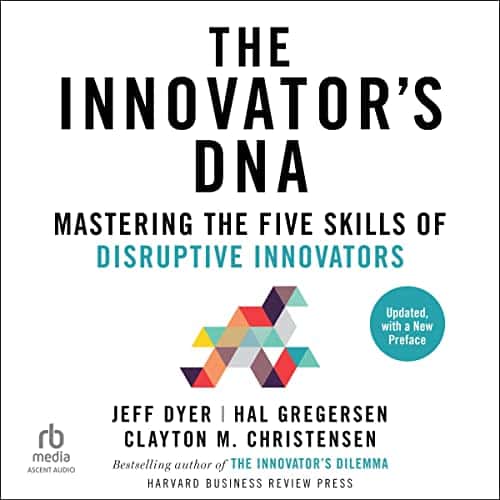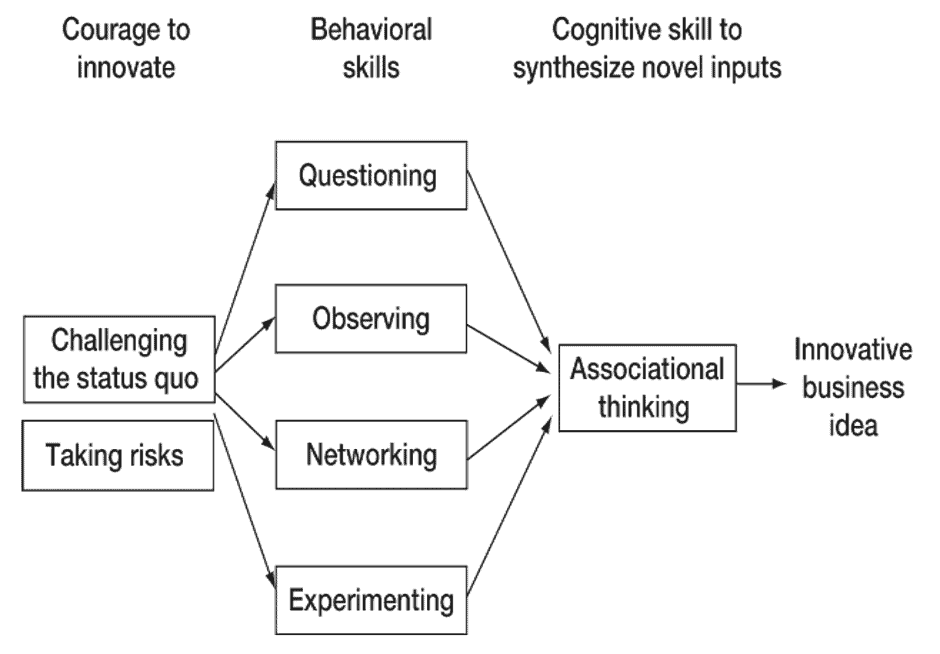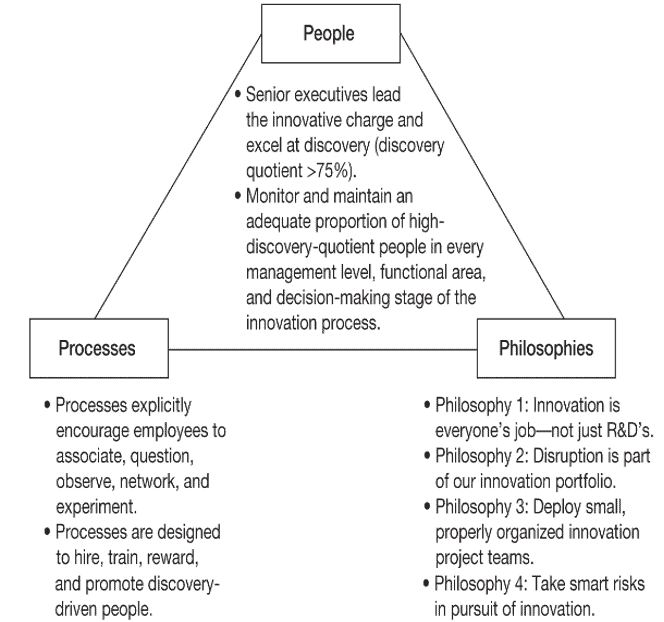The Innovator’s DNA by Jeff Dyer | Summary
Many people believe that it is impossible to be more creative because they view it as something you are born with or do not know where to begin. However, in The Innovator’s DNA: Mastering the Five Skills of Disruptive Innovators, Jeff Dyer shows you that innovation is a cognitive skill ingrained in your behaviors.
Specifically, five critical discovery behaviors will improve your ability to be creative:
- Associating
- Questioning
- Observing
- Networking
- Experimenting
Buy The Innovator’s DNA on Amazon

The Innovator’s DNA by Jeff Dyer
Mastering the Five Skills of Disruptive Innovators
Jeff Dyer wrote The Innovator’s DNA as a result of an eight-year study to understand disruptive leaders and how they implemented creative ideas to build innovative companies. “If you want innovation, you need creativity skills within the top management team of your organization.” This book focuses on how to get a creative idea as the first step in your innovation journey.
Download the PDF Book Summary for The Innovator’s DNA
Part One: Disruptive Innovation Starts with You
In the first part of The Innovator’s DNA, Jeff Dyer describes why innovative thinking is essential and discusses the skills to generate novel ideas. There are five discovery skills: associating, questioning, observing, networking, and experimenting.
Chapter 1 – The DNA of Disruptive Innovators
Many believe that creativity is genetic, but that is wrong. Within business, mostly everyone can be creative and innovative. Within The Innovator’s DNA, Jeff Dyer shows that innovators create amazing ideas through discovery. First, he introduces the cognitive discovery skill of association:
Association – “successfully connecting seemingly unrelated questions, problems, or ideas from different fields”
This phenomenon is also known as “the Medici effect,” which occurred due to the Medici family connecting creators from many disciplines, which generated many innovative ideas to spawn the Renaissance.
There are four behavioral discovery skills that trigger associational thinking:
- Questioning – “asking questions that challenge common wisdom” to “provoke new insights, connections, possibilities, and directions”
- Observing – “carefully watching the world around them to gain insights into and ideas for new ways of doing things”
- Networking – “finding and testing ideas through a diverse network of individuals who vary wildly in their backgrounds and perspectives”
- Experimenting – “constantly trying out new experiences and piloting new ideas”
Innovators gain the courage to innovate to change the status quo and take intelligent risks to bring about that change. As shown in this diagram, innovators get motivated to use their behavioral skills, which trigger the cognitive associating skill to synthesize novel inputs:

Jeff Dyer claims that these discovery skills constitute The Innovator’s DNA, which is the formula for creating innovative business ideas. However, most executives are hired for their delivery skills and tend to lack discovery skills. As a result, most companies fail at disruptive innovation.
Chapter 2 – Discovery Skill #1: Associating
In this chapter of The Innovator’s DNA, Jeff Dyer defines associating as follows:
Associating – “the ability to make surprising connections across areas of knowledge, industries, even geographies”
The brain stores knowledge by associating it with relevant knowledge that was previously stored. Also, it develops these associations through actively practicing the other discovery skills.
Innovators “connect wildly different ideas, objects, services, technologies, and disciplines to dish up new and unusual innovations.” Associating occurs intersection of diverse experience and culture with the following dynamics providing the best situations for new associations:
- Creating Odd Combinations of seemly uncommon and mismatched ideas.
- Zooming In and Out between the details and the big picture perspectives.
- Lego Thinking of creating and collecting many ideas to eventually find a good idea.
People with deep expertise in a specific field can generate innovative associations in two ways:
- Importing an idea from a different field into their area of deep expertise, or
- Exporting an idea from their area of deep expertise to a less familiar field.
These are several tips to develop associating skills:
- Force New Associations: Combine ideas that you would never naturally put together. If facing an issue, identify an unrelated item or idea, and reflect on it with your problem.
- Take on Another Company’s Persona: Take on opportunities and challenges using a perspective from someone at another company.
- Generate Metaphors and Analogies: Do activities that induce metaphors and analogies for your business products and services to view things from an atypical perspective.
- Build your Own Curiosity Box: Collect interesting objects into a box or bag and then use the objects randomly to help you figure out how to confront issues or opportunities
- SCAMPER: Rethink the problem or opportunity with SCAMPER: Substitute; Combine; Adapt; Magnify, minimize, modify; Put to other uses; Eliminate; and Reverse, rearrange.
- Give Yourself Space: Allow yourself breaks for walking or days off on vacation to get out of your typical environment to unearth new ideas.
Chapter 3 – Discovery Skill #2: Questioning
In this chapter of The Innovator’s DNA, Jeff Dyer demonstrates that innovators ask questions “to better understand what is and what might be.” Questioning allows innovators to challenge the status quo and discover creative insights. The right questions are descriptive or disruptive:
- Describe the Territory:
- Ask “What Is” Questions of who, what, when, where, and how to investigate what is (physically, intellectually, and emotionally) and gain empathy.
- Ask “What Caused” Questions to dive deeply into the drivers of what is or as to why things are the way they are.
- Disrupt the Territory:
- Ask “Why” and “Why Not” Questions to investigate a causal chain, determine the root cause, and create an innovative solution.
- Ask “What If” Questions for things that are broken or not perfect and imagine an ideal future by either:
- Imposing Constraints to force “out-of-the-box” thinking, invoke new associations, and provoke unconventional insights, or
- Eliminating Constraints of resource allocation, decision-making, or tech limitations that hinder thinking.
“Once you have learned to ask questions—relevant and appropriate and substantial questions —you have learned how to learn, and no one can keep you from learning whatever you need to know.” And so you can develop your questioning skills using these tips:
- Engage in Question Storming: Identify a challenge and list one question about it at a time until there are at least fifty questions. If in a group, allow the question to be written down and reflected upon until asking the next question.
- Cultivate Question Thinking: Actively translate statements about a problem into a question to strengthen the problem statement, instill personal responsibility, and create an action-oriented solution.
- Track Your Q/A Ratio: Track the ratio of Questions (Q) to Answers (A) in interactions. For example, in meetings, reflect on the questions you asked, the comments that could be reframed into questions, and the questions that were not obvious or not asked.
- Keep a Question-Centered Notebook: Capture your questions in your notebook to build a repository and review them periodically to quantify and categorize the questions that you are and are not asking.
Chapter 4 – Discovery Skill #3: Observing
In this chapter of The Innovator’s DNA, Jeff Dyer found that innovators are constantly observing their environment to generate creative ideas and insights. They tend to produce corporate insights these three types of observations:
- Having a need to get deep work accomplished, seeking potential solutions, and observing insufficient options for solution options.
- Observing people in various situations that are doing their work and determining the work that they desire to accomplish.
- “Observing people, processes, companies, or technologies” and finding an applicable solution for a different situation.
What causes someone to be great at observations? They tend to be successful at determining what work needs to be accomplished and how to effectively get it done by:
- Actively watching customers either in-person or virtually to observe what goods or services they buy to perform their work.
- Looking for surprises, anomalies, or differences in expectations.
- Observing in new environments like foreign countries, other companies, unusual conferences, or other interesting places.
These are several tips to develop observation skills:
- Observe Customers experiencing your good or service in real-life situations for as much of the customer journey as possible. Ask them questions regarding satisfaction, convenience, expectations, etc.
- Observe Companies to determine what it does and how it operates to apply insights to your business. If possible, visit the company in-person to investigate its products, strategy, and operations.
- Observe Whatever Strikes Your Fancy for 10 minutes every day. Record your findings in words, pictures, or video to later reflect and apply them to gain valuable insights.
- Observe With All Your Senses (sights, smells, sounds, touches, and tastes) and capture your findings in your journal to later investigate the insights.
Chapter 5 – Discovery Skill #4: Networking
In this chapter of The Innovator’s DNA, Jeff Dyer explains why networking is critical for success. Later, he shows you how to build and grow your network and harness it to spur creativity, test your innovative ideas, and find resources to launch ventures.
Successful innovators share their ideas within their area of expertise to those outside it to gain a vastly different perspective. In addition, they are always seeking to test unique ideas and get feedback through their network of diverse individuals.
Some believe that they are great at networking; however, like most executives, they are not innovative, lack a diverse network, and are networking for resources:
Resource Networking – “networking to sell themselves, to sell their companies, or to build relationships with people who possess desired resources”
Instead of networking for resources or career trajectory, innovators network to cultivate new ideas and insights:
Idea Networking – networking “to build a bridge into a different area of knowledge by interacting with someone with whom you, or people within your primary social networks, typically do not interact”
The critical factor in networks of innovators is diversity, as diverse ideas are fostered in a network of diverse backgrounds. A diverse network consists of people from “different business functions, companies, industries, countries, ethnic groups, socioeconomic groups, age group, political groups, and religions.
Building a diverse network requires much time and effort. However, podcaster Jordan Harbinger claims that consciously building and nurturing your network is critical for success personally and professionally. These are several tips to develop networking skills:
- Expand the Discovery of Your Network: List the top 10 people you would seek advice from when formulating or refining a novel idea. Examine the quantity of people and quality of backgrounds and if lacking in these areas, work to expand your network.
- Start a Mealtime Networking Plan: Share a meal weekly with someone from a different background or expertise than you. In the book, Never Eat Alone, Keith Ferrazzi discusses that sharing meals with others helps you cultivate the power of relationships.
- Plan to Attend at least Two Conferences in the Next Year: Learn from others’ ideas, perspectives, and issues by attending conferences within and outside your expertise. Engaging at conferences will rapidly help you grow and diversity your network.
- Start a Creative Community: Manage a monthly meetup group for open-minded individuals to inspire creativity and exchange ideas amongst each other.
- Invite Outside Experts: Bring in an expert from a different department, organization, or industry to have lunch with your team weekly. At lunch, understand their perspective and your innovation ideas and issues.
- Cross-train With Experts: Build relationships with “experts in different functions, industries, or geographic regions.” Then, participate in their training and meetings to learn about their work and environment.
Chapter 6 – Discovery Skill #5: Experimenting
In this chapter of The Innovator’s DNA, Jeff Dyer shows that innovators experiment to generate data and inspire innovative ideas. “Although questioning, observing, and networking provide data about the past (what was) and the present (what is), experimenting is best suited for generating data on what might work in the future.”
Jeff Bezos of Amazon has said, “Experiments are key to innovation because they rarely turn out as you expect, and you learn so much.” There are three types of experimentation that innovators conduct to generate data and spark new insights:
- Trying New Experiences: Explore an unfamiliar environment, culture, or location that may not seem to have any practical application for interactive learning and innovation.
- Taking Things Apart: Disassemble products, processes, and ideas apart either physically or intellectually to understand how it works and how to improve it.
- Testing Ideas: Create prototypes, processes, and pilots to gain insights. Most experiments will not go according to plan, but it is the only way to collect data to ultimately be successful.
All three are great for generating business ideas, and testing is critical to understand what works and what does not. These are several tips to develop experimenting skills:
- Cross Physical Borders: Get out of your comfort zone by visiting a new country, engaging in a new activity, joining a unique social group, or going to a unique lecture.
- Cross Intellectual Borders: Read articles from a new media source, newsletter, or magazine from an entirely different context, country, or industry.
- Develop a New Skill: Develop new skills or acquire new knowledge in an unfamiliar area by attending local classes in improv, photography, electronics, carpentry, etc. For exercise, eat that frog and try a new sport or yoga. Or learn about another function in your company.
- Disassemble a Product: Search for a broken product in your home, a junkyard, or flea market to take it apart and learn about its design, engineering, and operation.
- Build Prototypes: First, identify a product you would like to improve with specific changes and added features. Then, create a prototype of your new, improved invention from materials you have or take it further using computer modeling or 3-D printing.
- Regularly Pilot New Ideas: Run frequent pilot tests to test new ideas and embrace learning through trial and error. Understand that you will fail but try to view it as an opportunity to learn from failure.
- Go Trend Spotting: Search for emerging trends by conducting research in books or online, focusing on those who excel at identifying and predicting trends. Apply a trend of interest to conduct an interesting experiment regarding a new product or service.
Download the PDF Book Summary for The Innovator’s DNA
Part Two: The DNA of Disruptive Organizations and Teams
In the second part of The Innovator’s DNA, Jeff Dyer demonstrates innovation within organizations and teams. The chapters show how the most innovative companies and leaders emphasize the discovery skills within their people, processes, and philosophies.
Chapter 7 – The DNA of the World’s Most Innovative Companies
“How do companies comprising many people build the code for innovation?” In this chapter of The Innovator’s DNA, Jeff Dyer
In 2010, Dyer made his own list of innovative companies based on their future innovation expectation. Then, with Credit Suisse’s HOLT division, Dyer developed a methodology to calculate a company’s innovation premium:
Innovation Premium – the proportion of a company’s market value based on future expectations to product innovations that “cannot be accounted for from cash flows of its current products or businesses in its current markets”
The market prices this premium to account for the expectation of creating new goods, services, or markets with the expectation of higher future profits.
“What makes your firm so innovative?” The answer is having a culture of innovation to solve problems for profit. Within the Innovator’s DNA, Jeff Dyer has developed a hypothesis of the 3P framework to show that innovative companies put into place:
- “People who are like them (in other words, innovative),
- Processes that encourage the innovative skills they depend on (e.g., questioning, observing, networking, experimenting), and
- Philosophies that encourage everyone to innovate and take smart risks.”

In the following chapters of The Innovator’s DNA, Jeff Dyer provides how to implement the 3P framework of people, processes, and philosophies into your organization to be significantly more innovative.
Chapter 8 – People: Putting the Innovator’s DNA into Practice
In this chapter of The Innovator’s DNA, Jeff Dyer shows how innovative companies possess leaders that understand innovation, lead with strong discovery skills, and frequently contribute novel ideas. Additionally, these leaders hire discovery-driven people who are innovative and want to make an impact.
Innovative companies are typically led by high-discovery quotient leaders. These executives “lead the innovation charge by understanding how innovation works, improving their own discovery skills, and sharpening their ability to foster others’ innovation.”
Next, innovative companies have people that possess strong discovery skills in all levels and functional areas of the organization. However, organizations also need to execute on innovative ideas, so effective leaders balance team composition to have both discovery and delivery skills:
- Discovery-driven: associating, questioning, observing, networking, and experimenting
- Delivery-driven: analyzing, planning, detail-oriented implementing, and self-disciplined
Note that the relative balance of these skills for a specific team can vary depending on the team’s role in the innovation cycle. Here are examples of various departments with different ideal mixes between the two skillsets:
- Product-Development and Marketing Teams: Score, on average, higher for discovery.
- Finance and Operations Teams: Score, on average, higher for delivery.
- Business Development: Score, on average, about even between discovery and delivery.
Finally, innovative companies choose the right people “who possess not only complimentary discovery and delivery skills but also different expertise and diversity of backgrounds to look at problems through multiple lenses.” The most effective leaders combine complementary strengths within their teams to generate innovative ideas.
Lastly, innovative companies prioritize innovation at the senior-level position with a specific role focused on innovation. These companies consisted of more people with five discovery skills and knew how to effectively use them to succeed.
Chapter 9 – Processes: Putting the Innovator’s DNA into Practice
In this chapter of The Innovator’s DNA, Jeff Dyer shows how innovative organizations create a culture to encourage the discovery skills within their employees to spark new ideas. First, within the hiring process, innovative companies specifically recruit people with these characteristics:
- History of demonstrating strong discovery and creativity skills;
- Depth of expertise in a specific area and some breadth in a few others; and
- Passion for making an impact on others and in the world.
Also, innovative companies develop a culture that reflects the personality and behaviors of their leadership. These behaviors are captured within organizational processes that foster the discovery skills within their people. Here are examples of standardized discovery processes:
- Questioning:
- Five-Whys: This process requires asking why at least five times when facing an issue to determine the root cause and inspire ideas for innovative solutions.
- What-If: Consistently asking what-if questions is critical to innovation as it brainstorms solutions to impress your customers.
- Observing: Allow people to gain insights into issues through shadowing other departments or roles within their own company. Or they can observe consumers or other companies to spark new ideas.
- Networking:
- Internal: Challenge your people to submit innovative ideas to a panel of judges or leaders, who choose the best ideas and provide resources for execution. Also, provide ways to share innovative ideas amongst employees.
- External: Use open market innovation to encourage innovative ideas from external sources of experts, technology, sales channels, etc.
- Experimenting: Test out different versions of a new product using rapid prototypes in research laboratories; software for digital experimentation and data visualization; or pilot programs to allow users to “beta” test and provide feedback.
While we can deploy discovery skills as separate processes for idea generation within teams or organizations, these skills can be interconnected within a business system. For example, the design firm IDEO sparks innovation within a clearly defined process of delivery skills.
Chapter 10 – Philosophies: Putting the Innovator’s DNA into Practice
In this chapter of The Innovator’s DNA, Jeff Dyer discusses the four actionable philosophies that are embodied within the most innovative companies:
Philosophy 1: Innovation is Everyone’s Job, Not Just R&D’s: The top leaders should actively innovate as well as codify innovation, creativity, and curiosity into their core values. As everyone should be provided the resources to innovate, innovation should be an explicit, constant part of performance reviews.
Philosophy 2: Disruptive Innovation is Part of Our Innovation Portfolio: Companies invest at least 25 percent of their human and capital resources in platform and breakthrough innovation projects. This allocation signals an organization’s genuine commitment to innovation, as less than 5 percent indicates an inability to innovate.
Philosophy 3: Deploy Small, Properly Organized Innovation Project Teams: Small project teams allow new goods or services to be taken from idea to implementation. Therefore, leaders should build smart teams of diverse, capable individuals and empower them with big goals, sufficient resources, and the autonomy to do their work.
Philosophy 4: Take “Smart” Risks in the Pursuit of innovation: The most innovative companies foster a culture of taking risks and accepting failure to succeed. While companies that carefully weigh the risks, take the safe, typical path. Therefore, “breakthrough innovations require risk-taking to make them happen” and knowing that failure may occur.
Ultimately, these philosophies mold the leaders and their people in the world’s most innovative companies. They rely on these philosophies to create a culture that sparks innovative ideas and takes them to market.
Download the PDF Book Summary for The Innovator’s DNA
Conclusion and Next Steps
In The Innovator’s DNA, Jeff Dyer discusses what we know about disruptive innovation as a result of the discovery skills of Associating, Questioning, Observing, Networking, and Experimenting. Then, he demonstrates how people can develop these creative skills and companies can create an innovative culture to move from idea to implementation. For more on The Innovator’s DNA, check out the book here.







